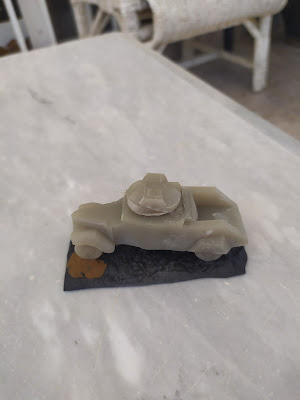Santa Faz and the SCW
This is not a wargaming article, just a short piece of history.
I only learned of this incident yesterday during a trip to the church with our Spanish walking group and feel it deserves telling to a wider audience.
Please understand I am not making judgements, or commenting on religious beliefs, just documenting history here.

Santa Faz Church as it is today
The Monasterio de la Santísima Faz was founded in 1453 by
Pedro Mena, a local priest inspired by the relic of the Holy Face (Santa Faz) of
Jesus. This piece of cloth, believed to have been used by Saint Veronica to
wipe Jesus’ face on his way to Calvary, bears the miraculous imprint of Jesus’
face.
Old postcard image of the relic
Within the monastery grounds also stands one of the best preserved
watch towers in the local area dating back to the 13th Century, this is part of the San Juan Tower Walk path which we did with Alex back in 2013.
https://baberonwargames.blogspot.com/2023/04/tower-walk-san-juan.html

The Santa Faz (Holly Face) of Alicante is a Catholic relic
that is venerated and kept in the Monasterio de la
Santísima Faz near the Spanish city of Alicante. The original canvas was a linen cloth
with bloodstains depicting a face. Years later, these stains were
highlighted with red paint. The tremendous devotion to the Santa Faz aroused
led to the canvas gradually being reduced in size due to the pieces cut off by
wealthy families. Therefore, a reliquary was placed on it with an image of a Santa
Faz in front and an image of the Virgin Mary behind. It is one of the three
faces recognized by the Vatican.
The relic is the object of a pilgrimage, which annually attracts more
than 260,000 pilgrims, this year (2025) being held today - May 1st.
Santa Faz in its reliquary today
At the start of the rebellion in Spain on 26
July 1936, the settling of scores, revenge, and murders began on both sides.
Alicante, remaining in the Republican zone and fell under the control of
militiamen during the first months of the war. The
monastery was attacked by Communist and Anarchist militia and the church was devastated, they burned the main Baroque style altarpiece,
destroying the statues of the facade and the Renaissance baptismal font.
Other churches and religious buildings were
also attacked and sacked on the same day around the Alicante area and the
casket holding the remains of Father Pedro Mena was burnt in San Juan.
Luckily the relic was saved thanks to the brave
intervention of some neighbours - Senor Antonio Ramos Alberola (Tonico Santamaría) who was
the local mayor and Senor Vicente Rocamora Onteniente, who sneaked into the chapel
and after breaking into the glass cabinet spirited the Santa Faz to safety,
hiding it in a shopping basket.
After spending the night at the local mayor's house, the relic was
transported by tram or municipal vehicle (depending on the story) to the Provincial
Council, where it was stored in the safe. Later, communist mayor Rafael Millá
Santos and former mayor Lorenzo Carbonell would save the relic from falling into
the hands of government officials who were requisitioning gold objects for the
Reparations Fund. The relic spent the next three years hidden at the Villa
Marco Estate, where it had been used, secretly during various religious
celebrations during the Civil War years.
The church was used as an aircraft factory by the Republic. The
monastery became a Checa – a facility created in the Republican zones to
detain, interrogate, torture, summarily try and execute (outside lawful courts)
those suspected of sympathizing with the rebels. Checas were mainly used by
individuals or groups related to political parties and unions outside the
general rule of law.
Some sources I have read say that after the occupation of Alicante by
Nationalist troops, the Littorio Regiment (which was a mixed regiment with both
Italian and Spanish personnel by this period) were housed in the monastery, they
left several pieces of graffiti depicting Mussolini and war scenes on the tower,
but I have found no photographic evidence to confirm this. Pending
archaeological studies, it is believed that a mass grave may exist. In 1989, a
replica of the casket of Mósén Pedro Mena was made.
After the Civil War, the church was restored but did not reopen for
three years! A new altar was built, much more spectacular than the original,
according to plans by architect Juan Vidal Ramos and thanks to donations from
Manuel Prytz.

The alter today
































